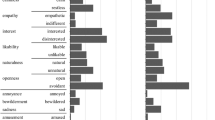Abstract
The aim of this study was to investigate the effect of conversational role (speaking versus listening) and conversational agreement (agreement versus disagreement) on eye gaze toward the interlocutor in the context of controversial, political conversations. Previous studies have only examined these variables independently of one another and typically not in face-to-face conversations. Participants briefly discussed four historically partisan social issues with an experimental confederate posing as a participant, who either agreed or disagreed with the viewpoints endorsed by the participant. Participants’ gaze toward the confederate was recorded using a hidden video camera. Consistent with previous research, our results showed that participants looked at the confederate more when listening than speaking. Notably, the magnitude of this listening-speaking difference depended on agreement condition; compared to a baseline non-controversial conversation, disagreement (but not agreement) exacerbated the listening-speaking difference, particularly by increasing gaze during listening. Follow-up analyses showed that emotion, gender, and political ideology did not moderate this effect. Together, these results shed light on factors that affect eye gaze during politically-charged conversations and show that both conversational role and level of agreement work together to exert an influence.




Similar content being viewed by others
References
Argyle, M., & Cook, M. (1976). Gaze and mutual gaze. Cambridge: Cambridge University Press.
Argyle, M., & Dean, J. (1965). Eye-contact, distance and affiliation. Sociometry, 28, 289–304.
Argyle, M., Lefebvre, L., & Cook, M. (1974). The meaning of five patterns of gaze. European Journal of Social Psychology, 4(2), 125–136.
Bohannon, L. S., Herbert, A. M., Pelz, J. B., & Rantanen, E. M. (2013). Eye contact and video-mediated communication: A review. Displays, 34(2), 177–185.
Chen, F. S., Minson, J. A., Schöne, M., & Heinrichs, M. (2013). In the eye of the beholder: Eye contact increases resistance to persuasion. Psychological Science, 24(11), 2254–2261.
Coss, R. G., Marks, S., & Ramakrishnan, U. (2002). Early environment shapes the development of gaze aversion by wild bonnet macaques (Macaca radiata). Primates, 43(3), 217–222.
Doherty-Sneddon, G., Anderson, A., O’Malley, C., Langton, S., Garrod, S., & Bruce, V. (1997). Face-to-face and video-mediated communication: A comparison of dialogue structure and task performance. Journal of experimental psychology: applied, 3(2), 105.
Doherty-Sneddon, G., & Phelps, F. G. (2005). Gaze aversion: A response to cognitive or social difficulty?Memory & Cognition, 33(4), 727–733.
Dovidio, J. F., & Ellyson, S. L. (1982). Decoding visual dominance: Attributions of power based on relative percentages of looking while speaking and looking while listening. Social Psychology Quarterly, 45, 106–113.
Emery, N. J. (2000). The eyes have it: the neuroethology, function and evolution of social gaze. Neuroscience & Biobehavioral Reviews, 24(6), 581–604.
Farabee, D. J., Holcom, M. L., Ramsey, S. L., & Cole, S. G. (1993). Social anxiety and speaker gaze in a persuasive atmosphere. Journal of Research in Personality, 27(4), 365–376.
Glenberg, A. M., Schroeder, J. L., & Robertson, D. A. (1998). Averting the gaze disengages the environment and facilitates remembering. Memory & Cognition, 26(4), 651–658.
Haddington, P. (2006). The organization of gaze and assessments as resources for stance taking. Text & Talk, 26(3), 281–328.
Hall, J. A., Coats, E. J., & LeBeau, L. S. (2005). Nonverbal behavior and the vertical dimension of social relations: A meta-analysis. Psychological Bulletin, 131, 898–924.
Kelly, E. W., & True, J. H. (1980). Eye contact and communication of facilitative conditions. Perceptual and Motor Skills, 51(3), 815–820.
Kendon, A. (1967). Some functions of gaze-direction in social interaction. Acta psychologica, 26, 22–63.
Khalid, S., Deska, J. C., & Hugenberg, K. (2016). The eyes are the windows to the mind: Direct eye gaze triggers the ascription of others’ minds. Personality and Social Psychology Bulletin, 42(12), 1666–1677.
Kleinke, C. L. (1986). Gaze and eye contact: A research review. Psychological Bulletin, 100(1), 78.
Kreysa, H., Kessler, L., & Schweinberger, S. R. (2016). Direct speaker gaze promotes trust in truth-ambiguous statements. PloS one,11(9).
Langer, J., Lim, K., Fernandez, M., & Rodebaugh, H. (2017). Social anxiety disorder is passociated with reduced eye contact during conversation primed for conflict. Cognitive Therapy and Research, 41(2), 220–229.
Mehrabian, A., & Williams, M. (1969). Nonverbal concomitants of perceived and intended persuasiveness. Journal of Personality and Social Psychology, 13(1), 37.
O’Malley, C., Langton, S., Anderson, A., Doherty-Sneddon, G., & Bruce, V. (1996). Comparison of face-to-face and video-mediated interaction. Interacting with Computers, 8(2), 177–192.
Rutter, D. R., & Stephenson, G. M. (1977). The role of visual communication in synchronising conversation. European Journal of Social Psychology, 7(1), 29–37.
Skuse, D., Morris, J., & Lawrence, K. (2003). The amygdala and development of the social brain. Annals of the New York Academy of Sciences, 1008(1), 91–101.
Stanley, G., & Martin, D. S. (1968). Eye-contact and the recall of material involving competitive and noncompetitive associations. Psychonomic Science, 13(6), 337–338.
Tang, D., & Schmeichel, B. (2015). Look me in the eye: Manipulated eye gaze affects dominance mindsets. Journal of Nonverbal Behavior, 39(2), 181–194.
Timney, B., & London, H. (1973). Body language concomitants of persuasiveness and persuasibility in dyadic interaction. International Journal of Group Tensions, 3, 48–67.
Author information
Authors and Affiliations
Corresponding author
Ethics declarations
Conflict of interest
Cali Tyler declares that she has no conflict of interest. Sam Light declares that he has no conflict of interest. Anika Notthoff declares that she has no conflict of interest. Laura Cacciamani declares that she has no conflict of interest.
Additional information
Publisher’s note
Springer Nature remains neutral with regard to jurisdictional claims in published maps and institutional affiliations.
Rights and permissions
About this article
Cite this article
Tyler, C., Light, S., Notthoff, A. et al. Eye Gaze During Controversial Conversations Depends on Agreement and Conversational Role. J Nonverbal Behav 45, 351–366 (2021). https://doi.org/10.1007/s10919-021-00363-5
Accepted:
Published:
Issue Date:
DOI: https://doi.org/10.1007/s10919-021-00363-5




